Longtao Huang
AIR: A Systematic Analysis of Annotations, Instructions, and Response Pairs in Preference Dataset
Apr 04, 2025Abstract:Preference learning is critical for aligning large language models (LLMs) with human values, yet its success hinges on high-quality datasets comprising three core components: Preference \textbf{A}nnotations, \textbf{I}nstructions, and \textbf{R}esponse Pairs. Current approaches conflate these components, obscuring their individual impacts and hindering systematic optimization. In this work, we propose \textbf{AIR}, a component-wise analysis framework that systematically isolates and optimizes each component while evaluating their synergistic effects. Through rigorous experimentation, AIR reveals actionable principles: annotation simplicity (point-wise generative scoring), instruction inference stability (variance-based filtering across LLMs), and response pair quality (moderate margins + high absolute scores). When combined, these principles yield +5.3 average gains over baseline method, even with only 14k high-quality pairs. Our work shifts preference dataset design from ad hoc scaling to component-aware optimization, offering a blueprint for efficient, reproducible alignment.
Correlation-Aware Graph Convolutional Networks for Multi-Label Node Classification
Nov 26, 2024



Abstract:Multi-label node classification is an important yet under-explored domain in graph mining as many real-world nodes belong to multiple categories rather than just a single one. Although a few efforts have been made by utilizing Graph Convolution Networks (GCNs) to learn node representations and model correlations between multiple labels in the embedding space, they still suffer from the ambiguous feature and ambiguous topology induced by multiple labels, which reduces the credibility of the messages delivered in graphs and overlooks the label correlations on graph data. Therefore, it is crucial to reduce the ambiguity and empower the GCNs for accurate classification. However, this is quite challenging due to the requirement of retaining the distinctiveness of each label while fully harnessing the correlation between labels simultaneously. To address these issues, in this paper, we propose a Correlation-aware Graph Convolutional Network (CorGCN) for multi-label node classification. By introducing a novel Correlation-Aware Graph Decomposition module, CorGCN can learn a graph that contains rich label-correlated information for each label. It then employs a Correlation-Enhanced Graph Convolution to model the relationships between labels during message passing to further bolster the classification process. Extensive experiments on five datasets demonstrate the effectiveness of our proposed CorGCN.
Towards Rehearsal-Free Multilingual ASR: A LoRA-based Case Study on Whisper
Aug 20, 2024



Abstract:Pre-trained multilingual speech foundation models, like Whisper, have shown impressive performance across different languages. However, adapting these models to new or specific languages is computationally extensive and faces catastrophic forgetting problems. Addressing these issues, our study investigates strategies to enhance the model on new languages in the absence of original training data, while also preserving the established performance on the original languages. Specifically, we first compare various LoRA-based methods to find out their vulnerability to forgetting. To mitigate this issue, we propose to leverage the LoRA parameters from the original model for approximate orthogonal gradient descent on the new samples. Additionally, we also introduce a learnable rank coefficient to allocate trainable parameters for more efficient training. Our experiments with a Chinese Whisper model (for Uyghur and Tibetan) yield better results with a more compact parameter set.
fairBERTs: Erasing Sensitive Information Through Semantic and Fairness-aware Perturbations
Jul 11, 2024Abstract:Pre-trained language models (PLMs) have revolutionized both the natural language processing research and applications. However, stereotypical biases (e.g., gender and racial discrimination) encoded in PLMs have raised negative ethical implications for PLMs, which critically limits their broader applications. To address the aforementioned unfairness issues, we present fairBERTs, a general framework for learning fair fine-tuned BERT series models by erasing the protected sensitive information via semantic and fairness-aware perturbations generated by a generative adversarial network. Through extensive qualitative and quantitative experiments on two real-world tasks, we demonstrate the great superiority of fairBERTs in mitigating unfairness while maintaining the model utility. We also verify the feasibility of transferring adversarial components in fairBERTs to other conventionally trained BERT-like models for yielding fairness improvements. Our findings may shed light on further research on building fairer fine-tuned PLMs.
UniPSDA: Unsupervised Pseudo Semantic Data Augmentation for Zero-Shot Cross-Lingual Natural Language Understanding
Jun 24, 2024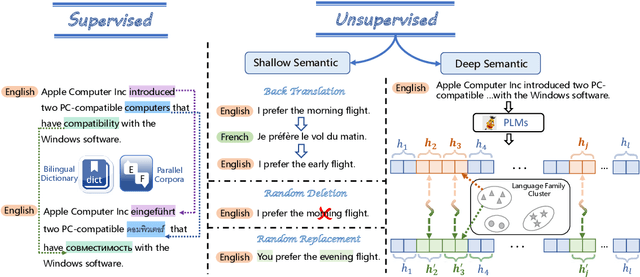
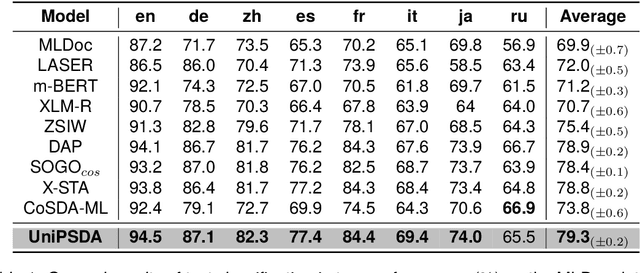
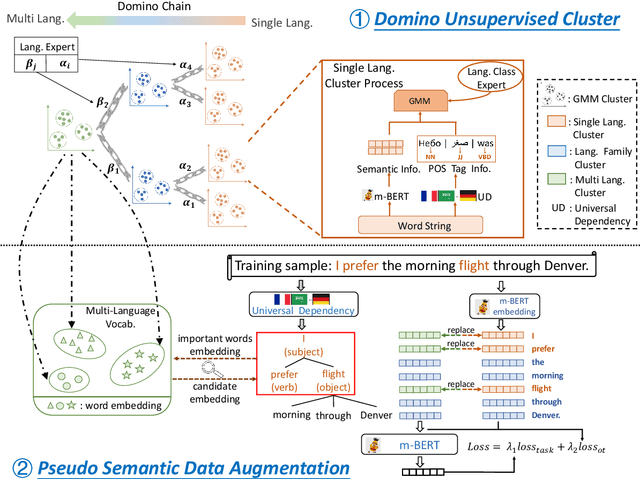
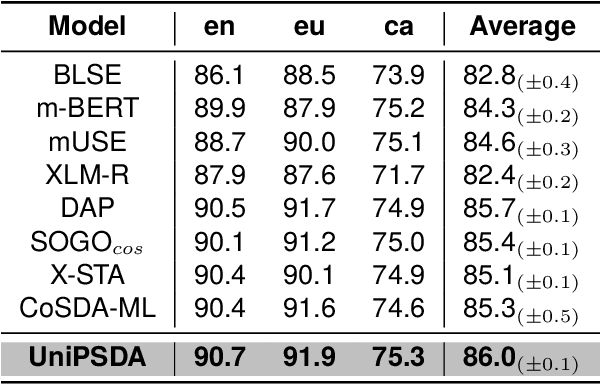
Abstract:Cross-lingual representation learning transfers knowledge from resource-rich data to resource-scarce ones to improve the semantic understanding abilities of different languages. However, previous works rely on shallow unsupervised data generated by token surface matching, regardless of the global context-aware semantics of the surrounding text tokens. In this paper, we propose an Unsupervised Pseudo Semantic Data Augmentation (UniPSDA) mechanism for cross-lingual natural language understanding to enrich the training data without human interventions. Specifically, to retrieve the tokens with similar meanings for the semantic data augmentation across different languages, we propose a sequential clustering process in 3 stages: within a single language, across multiple languages of a language family, and across languages from multiple language families. Meanwhile, considering the multi-lingual knowledge infusion with context-aware semantics while alleviating computation burden, we directly replace the key constituents of the sentences with the above-learned multi-lingual family knowledge, viewed as pseudo-semantic. The infusion process is further optimized via three de-biasing techniques without introducing any neural parameters. Extensive experiments demonstrate that our model consistently improves the performance on general zero-shot cross-lingual natural language understanding tasks, including sequence classification, information extraction, and question answering.
On the Role of Long-tail Knowledge in Retrieval Augmented Large Language Models
Jun 24, 2024
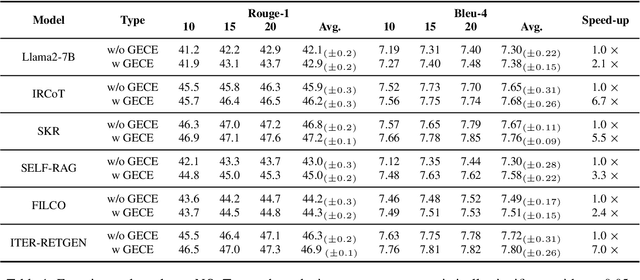
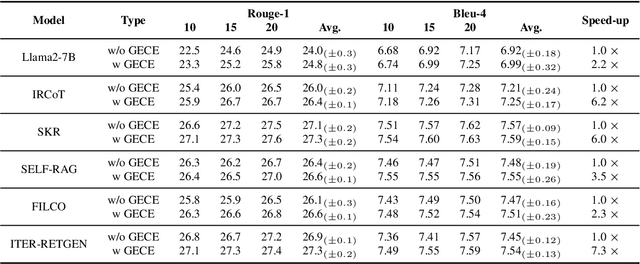
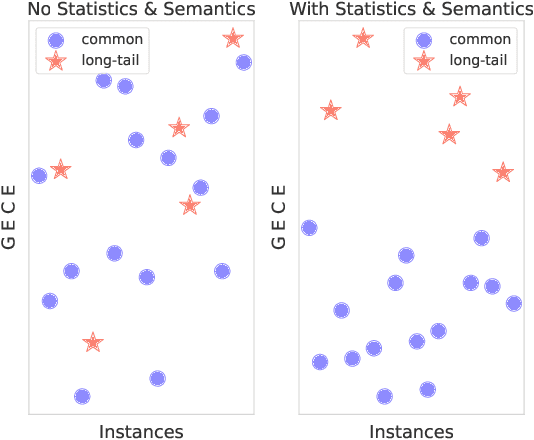
Abstract:Retrieval augmented generation (RAG) exhibits outstanding performance in promoting the knowledge capabilities of large language models (LLMs) with retrieved documents related to user queries. However, RAG only focuses on improving the response quality of LLMs via enhancing queries indiscriminately with retrieved information, paying little attention to what type of knowledge LLMs really need to answer original queries more accurately. In this paper, we suggest that long-tail knowledge is crucial for RAG as LLMs have already remembered common world knowledge during large-scale pre-training. Based on our observation, we propose a simple but effective long-tail knowledge detection method for LLMs. Specifically, the novel Generative Expected Calibration Error (GECE) metric is derived to measure the ``long-tailness'' of knowledge based on both statistics and semantics. Hence, we retrieve relevant documents and infuse them into the model for patching knowledge loopholes only when the input query relates to long-tail knowledge. Experiments show that, compared to existing RAG pipelines, our method achieves over 4x speedup in average inference time and consistent performance improvement in downstream tasks.
KEHRL: Learning Knowledge-Enhanced Language Representations with Hierarchical Reinforcement Learning
Jun 24, 2024Abstract:Knowledge-enhanced pre-trained language models (KEPLMs) leverage relation triples from knowledge graphs (KGs) and integrate these external data sources into language models via self-supervised learning. Previous works treat knowledge enhancement as two independent operations, i.e., knowledge injection and knowledge integration. In this paper, we propose to learn Knowledge-Enhanced language representations with Hierarchical Reinforcement Learning (KEHRL), which jointly addresses the problems of detecting positions for knowledge injection and integrating external knowledge into the model in order to avoid injecting inaccurate or irrelevant knowledge. Specifically, a high-level reinforcement learning (RL) agent utilizes both internal and prior knowledge to iteratively detect essential positions in texts for knowledge injection, which filters out less meaningful entities to avoid diverting the knowledge learning direction. Once the entity positions are selected, a relevant triple filtration module is triggered to perform low-level RL to dynamically refine the triples associated with polysemic entities through binary-valued actions. Experiments validate KEHRL's effectiveness in probing factual knowledge and enhancing the model's performance on various natural language understanding tasks.
NoisyGL: A Comprehensive Benchmark for Graph Neural Networks under Label Noise
Jun 07, 2024

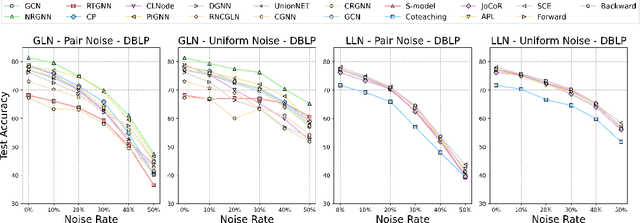

Abstract:Graph Neural Networks (GNNs) exhibit strong potential in node classification task through a message-passing mechanism. However, their performance often hinges on high-quality node labels, which are challenging to obtain in real-world scenarios due to unreliable sources or adversarial attacks. Consequently, label noise is common in real-world graph data, negatively impacting GNNs by propagating incorrect information during training. To address this issue, the study of Graph Neural Networks under Label Noise (GLN) has recently gained traction. However, due to variations in dataset selection, data splitting, and preprocessing techniques, the community currently lacks a comprehensive benchmark, which impedes deeper understanding and further development of GLN. To fill this gap, we introduce NoisyGL in this paper, the first comprehensive benchmark for graph neural networks under label noise. NoisyGL enables fair comparisons and detailed analyses of GLN methods on noisy labeled graph data across various datasets, with unified experimental settings and interface. Our benchmark has uncovered several important insights that were missed in previous research, and we believe these findings will be highly beneficial for future studies. We hope our open-source benchmark library will foster further advancements in this field. The code of the benchmark can be found in https://github.com/eaglelab-zju/NoisyGL.
DAFNet: Dynamic Auxiliary Fusion for Sequential Model Editing in Large Language Models
May 31, 2024



Abstract:Recently, while large language models (LLMs) have demonstrated impressive results, they still suffer from hallucination, i.e., the generation of false information. Model editing is the task of fixing factual mistakes in LLMs; yet, most previous works treat it as a one-time task, paying little attention to ever-emerging mistakes generated by LLMs. We address the task of sequential model editing (SME) that aims to rectify mistakes continuously. A Dynamic Auxiliary Fusion Network (DAFNet) is designed to enhance the semantic interaction among the factual knowledge within the entire sequence, preventing catastrophic forgetting during the editing process of multiple knowledge triples. Specifically, (1) for semantic fusion within a relation triple, we aggregate the intra-editing attention flow into auto-regressive self-attention with token-level granularity in LLMs. We further leverage multi-layer diagonal inter-editing attention flow to update the weighted representations of the entire sequence-level granularity. (2) Considering that auxiliary parameters are required to store the knowledge for sequential editing, we construct a new dataset named \textbf{DAFSet}, fulfilling recent, popular, long-tail and robust properties to enhance the generality of sequential editing. Experiments show DAFNet significantly outperforms strong baselines in single-turn and sequential editing. The usage of DAFSet also consistently improves the performance of other auxiliary network-based methods in various scenarios
S-Eval: Automatic and Adaptive Test Generation for Benchmarking Safety Evaluation of Large Language Models
May 28, 2024Abstract:Large Language Models have gained considerable attention for their revolutionary capabilities. However, there is also growing concern on their safety implications, making a comprehensive safety evaluation for LLMs urgently needed before model deployment. In this work, we propose S-Eval, a new comprehensive, multi-dimensional and open-ended safety evaluation benchmark. At the core of S-Eval is a novel LLM-based automatic test prompt generation and selection framework, which trains an expert testing LLM Mt combined with a range of test selection strategies to automatically construct a high-quality test suite for the safety evaluation. The key to the automation of this process is a novel expert safety-critique LLM Mc able to quantify the riskiness score of an LLM's response, and additionally produce risk tags and explanations. Besides, the generation process is also guided by a carefully designed risk taxonomy with four different levels, covering comprehensive and multi-dimensional safety risks of concern. Based on these, we systematically construct a new and large-scale safety evaluation benchmark for LLMs consisting of 220,000 evaluation prompts, including 20,000 base risk prompts (10,000 in Chinese and 10,000 in English) and 200,000 corresponding attack prompts derived from 10 popular adversarial instruction attacks against LLMs. Moreover, considering the rapid evolution of LLMs and accompanied safety threats, S-Eval can be flexibly configured and adapted to include new risks, attacks and models. S-Eval is extensively evaluated on 20 popular and representative LLMs. The results confirm that S-Eval can better reflect and inform the safety risks of LLMs compared to existing benchmarks. We also explore the impacts of parameter scales, language environments, and decoding parameters on the evaluation, providing a systematic methodology for evaluating the safety of LLMs.
 Add to Chrome
Add to Chrome Add to Firefox
Add to Firefox Add to Edge
Add to Edge